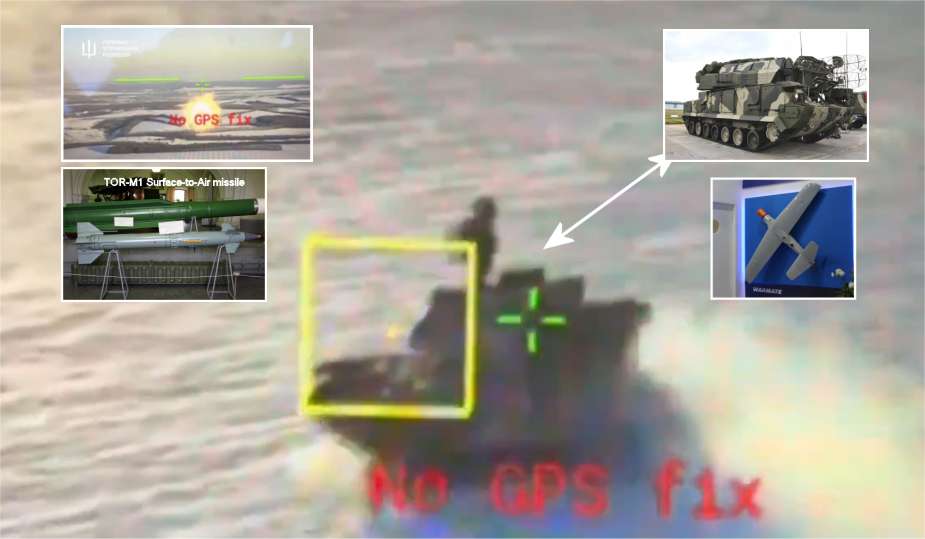- Army
- Conflicts in the world
- Israel - Iran conflict 2025
- Pakistan - India Conflict 2025
- Russia Ukraine War 2022
- Libya conflict day by day
- HAMAS - Israel War 2023
- Operation Serval in Mali French Army
- Sangaris operation Central African Republic
- Sangaris opération militaire République Centreafrique
- Ukraine - Russia conflict
- Syria conflict news
- Defence & Security Industry Technology
- Armies in the world
- Analysis Defense and Security Industry
- Conflicts in the world
- Navy
- Air
Polish Warmate loitering munition triumphs against Russian TOR-M1 air defense system
On January 20, 2024, the Ukrainian armed forces shared a video on their social media platforms, revealing a successful operation to neutralize a Russian TOR-M1 air defense system. This operation was carried out near the Russo-Ukrainian border by soldiers from the 15th Separate Artillery Reconnaissance Brigade, utilizing Polish-made Warmate loitering munitions.
Follow Army Recognition on Google News at this link

Russian Air Defense System TOR-M1's unsuccessful attempt to intercept the Polish Warmate loitering munition and get hit (Picture source: Ukraine Social Media and Wikimedia)
Ukrainian intelligence services had identified the presence of the Russian TOR air defense system, prompting this operation. The footage captured by Warmate sensors documents the critical moments when Russian forces attempted to counter the assault by firing a missile from the TOR-M1 system at the drone. However, their efforts proved futile as the missile missed its target, and the anti-aircraft missile exploded in front of the hostile UAV without considerable damage. The Warmate drone then continued its mission successfully, ultimately destroying the costly Russian surface-to-air missile system.
The outcome of the strike remains undisclosed, leaving us to speculate on the potential impact of the 1.4 kg high-explosive warhead carried by the Warmate. This warhead should have been capable of inflicting damage to vital subsystems, potentially rendering the air defense system inoperable until extensive repairs or even destruction.
Regarding the TOR-M1's unsuccessful attempt to intercept the drone, it's worth noting that in Russia, the Tor system is highly regarded as one of the most effective ways to counter unmanned aerial vehicles, particularly low-flying threats. The Tor system is equipped with its standalone surveillance and targeting radar, designed for close air defense support of nearby allied units. Consequently, it is specifically designed to engage simple, low-flying targets.
However, unlike the previous incident where the attackers took advantage of the Tor's transportation mode, this recent encounter was a head-on duel in which a Polish-made drone emerged victorious. Interestingly, this same loitering munition was responsible for incapacitating two Pantsir-S1 anti-aircraft missile and gunnery systems of the Russian army two weeks ago. While the success of the Warmate is evident, it's important to note that other types of attack UAVs and loitering munitions, such as RAM II or Switchblade 600, have also been observed targeting Tor systems. According to the Oryx OSINT community, at least 49 Russian Tor systems have been either destroyed, damaged, or captured throughout the large-scale conflict with Ukraine since February 2022.
The Warmate loitering munition measures 1 meter in length, boasts a 1.4-meter wingspan, and weighs 5 kilograms. It can be easily transported by a single soldier using a backpack and features foldable main wings and V-shaped tail fins.
Warmate can be employed for reconnaissance in various combat scenarios, with the option to carry different types of payloads or explosive warheads. It can be deployed in under five minutes, day or night, with a range of 4 kilometers in open terrain or 1 kilometer in forested areas.
This versatile system can function as a standalone unit, be transported by land forces, or accompany special operations units. Its design allows for installation on various vehicles, including cars and APCs, and integrates seamlessly with onboard systems through the Ground Control Station and Ground Data Terminal.
Unlike traditional anti-tank guided missiles, Warmate offers a significantly larger operational radius, allowing for extended target detection and observation over an extended period, with a flight time of approximately 70 minutes. Additionally, it can be equipped with a laser-seeking warhead.
The Warmate operates autonomously, enabling real-time airborne warfare operations through video feeds from its surveillance subsystem. Control modules automate most flight phases, but the operator retains complete control and can activate ARMED mode for combat tasks.
Developed by the Polish WB Group, the Warmate loitering munition has gained popularity in modern warfare due to its effectiveness and versatility. It has become the preferred choice for precision strikes, particularly in asymmetric conflicts with advanced air defenses. Currently, it is in service with several armed forces, including the Polish and Ukrainian military, and has garnered interest from NATO member states, solidifying its international reputation. Its adoption by countries in the Middle East and significant procurement by India in 2023 highlight its status as a highly sought-after tactical weapon in global defense arsenals. The increasing utilization of the Warmate reflects a broader trend toward more autonomous and precise weaponry in contemporary military strategies.


























